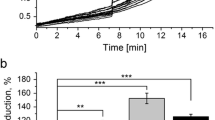Abstract
Mitochondria contain photosensitive chromophores that can be ac-tivated or inhibited by light in the visible range. Rather than utilizing light en-ergy, however, mitochondrial electron transport oxidation-reduction reaction and energy coupling could be stimulated or damaged by visible light Our pre-vious work demonstrated that reactive oxygen species (ROS) were generated in cultured astrocytes after visible laser irradiation. With confocal fluorescence microscopy, we found that ROS were generated mostly from mitochondria. This mitochondrial ROS (mROS) formation plays a critical role in photoirradiation-induced phototoxicity and apoptosis. In this study, we mea-sured changes of mitochondrial calcium level ([Ca2+]m) in cultured astrocytes (RBA-1 cell line) irradiated with blue light and examined the association between mROS formation and [Ca2+]m level changes. Changes of mtracellular ROS and [Ca2+]m were visualized using fluorescent probes 2′,7′-dichlorodihy-drofluorescein (DCF), and rhod-2 After exposure to visible light irradiation, RBA-1 astrocytes showed a rapid increase in ROS accumulation particularly in the mitochondrial area. Increase in [Ca2+]m was also induced by photo-irradiation. The levels of increase in DCF fluorescence intensity varied among different astrocytes. Some of the cells generated much higher levels of ROS than others. For those cells that had high ROS levels, mitochondrial Ca2+ levels were also high. In cells that had mild ROS levels, mitochondrial Ca2+ levels were only slightly increased. The rate of increase in DCF fluorescence seemed to be close to the rate of rhod-2 fluorescence increase. There is a positive and close correlation between mitochondrial ROS levels and mitochondrial Ca2+ levels in astrocytes irradiated by visible light.
Access this chapter
Tax calculation will be finalised at checkout
Purchases are for personal use only
Preview
Unable to display preview. Download preview PDF.
Similar content being viewed by others
References
Aggarwal, B.B., A.T. Quintanilha, R. Cammack, et al. 1978. Damage to mitochondrial electron transport and energy coupling by visible light. Biochim. Biophys. Acta 502: 367–382.
Ramadan-Talib, Z. & J. Prebble. 1978. Photosensitivity of respiration in Neurospora mitochondria. A protective role for carotenoid. Biochem. J. 176: 767–775.
Hockberger, P.E., T.A. Skimna, V.E. Centonze, et al. 1999. Activation of flavincontaining oxidases underlies light-induced production of H2O2 in mammalian cells. Proc. Natl. Acad. Sci. USA 96: 6255–6260.
Alexandratou, E., D. Yova, P. Handris, et al. 2002. Human fibroblast alterations induced by low power laser irradiation at the single cell level using confocal microscopy. Photochem. Photobiol. Sci. 1: 547–552.
Jou, M.J., S.B. Jou, H.M. Chen, et al. 2002. Critical role of mitochondrial reactive oxygen species formation in visible laser irradiation-induced apoptosis in rat brain astrocytes (RBA-1). J. Biomed. Sci. 9: 507–516.
Vacca, R.A., L. Moro, V.A. Petragallo, et al. 1997. The irradiation of hepatocytes with He-Ne laser causes an increase of cytosolic free calcium concentration and an increase of cell membrane potential, correlated with it, both increases taking place in an oscillatory manner. Biochem. Mol. Biol. Intl. 43: 1005–1014.
Lubart, R., H. Friedmann, M. Sinyakov, et al. 1997. Changes in calcium transport in mammalian sperm mitochondria and plasma membranes caused by 780 nm irradiation. Lasers Surg. Med. 21: 493–499.
Breitbart, H., T. Levinshal, N. Cohen, et al. 1996. Changes in calcium transport in mammalian sperm mitochondria and plasma membrane irradiated at 633 nm (HeNe laser). J. Photochem. Photobiol. Biol. 34: 117–121.
Lubart, R., H. Friedmann, T. Levinshal, et al. 1992. Effect of light on calcium transport in bull sperm cells. J. Photochem. Photobiol. Biol. 15: 337–341.
Dykens, J.A. 1994. Isolated cerebral and cerebellar mitochondria produce free radicals when exposed to elevated Ca2+ and Na+: implications for neurodegeneration. J. Neurochem. 63: 584–591.
Territo, PR., S.A. French, M.C. Dunleavy, et al. 2001. Calcium activation of heart mitochondrial oxidative phosphorylation: rapid kinetics of mV02, NADH, and light scattering. J. Biol. Chem. 276: 2586–2599.
Jou, M.J., T.I. Peng & S.S. Sheu. 1996. Histamine induces oscillations of mitochondrial free Ca2+ concentration in single cultured rat brain astrocytes. J. Physiol. 497: 299–308.
Peng, T.I., M.J. Jou, S.S. Sheu, et al. 1998. Visualization of NMDA receptor-induced mitochondrial calcium accumulation in striatal neurons. Exp. Neurol. 149: 1–12.
Peng, T.I. & J.T. Greenamyre. 1998. Privileged access to mitochondria of calcium influx through N-methyl-D-aspartate receptors. Mol. Pharmacol. 53: 974–980.
Kruman, I.I. & M.P. Mattson. 1999. Pivotal role of mitochondrial calcium uptake in neural cell apoptosis and necrosis. J. Neurochem. 72: 529–540.
Reynolds, I.J. & T.G. Hastings. 1995. Glutamate induces the production of reactive oxygen species in cultured forebrain neurons following NMDA receptor activation. J. Neurosci. 15: 3318–3327.
Pei, Z.M., Y. Murata, G. Benning, et al. 2000. Calcium channels activated by hydrogen peroxide mediate abscisic acid signalling in guard cells. Nature 406: 731–734.
Wang, H. & J.A. Joseph. 2000. Mechanisms of hydrogen peroxide-induced calcium dysregulation in PC12 cells. Free Rad. Biol. Med. 28: 1222–1231.
Author information
Authors and Affiliations
Corresponding author
Editor information
Rights and permissions
Copyright information
© 2004 Springer-Verlag Berlin Heidelberg
About this chapter
Cite this chapter
Jou, MJ., Jou, SB., Guo, MJ., Wu, HY., Peng, TI. (2004). Mitochondrial Reactive Oxygen Species Generation and Calcium Increase Induced by Visible Light in Astrocytes. In: Lee, H.K., DiMauro, S., Tanaka, M., Wei, YH. (eds) Mitochondrial Pathogenesis. Annals of the New York Academy of Sciences, vol 1011. Springer, Berlin, Heidelberg. https://doi.org/10.1007/978-3-662-41088-2_5
Download citation
DOI: https://doi.org/10.1007/978-3-662-41088-2_5
Publisher Name: Springer, Berlin, Heidelberg
Print ISBN: 978-1-57331-491-6
Online ISBN: 978-3-662-41088-2
eBook Packages: Springer Book Archive




